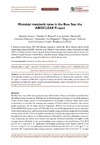Identificador persistente para citar o vincular este elemento:
https://accedacris.ulpgc.es/jspui/handle/10553/60010
| Título: | Microbial metabolic rates in the Ross Sea: the ABIOCLEAR Project | Autores/as: | Azzaro, Maurizio Packard, Theodore T. Monticelli, Luis Salvador Maimone, Giovanna Rappazzo, Alessandro Ciro Azzaro, Filippo Grilli, Federica Crisafi, Ermanno La Ferla, Rosabruna |
Clasificación UNESCO: | 251001 Oceanografía biológica | Palabras clave: | Bacterial-Growth Efficiency Electron-Transport Activity Leucine Incorporation Biomass Production Mediterranean Sea, et al. |
Fecha de publicación: | 2019 | Publicación seriada: | Nature Conservation | Resumen: | The Ross Sea is one of the most productive areas of the Southern Ocean and includes several functionally different marine ecosystems. With the aim of identifying signs and patterns of microbial response to current climate change, seawater microbial populations were sampled at different depths, from surface to the bottom, at two Ross Sea mooring areas southeast of Victoria Land in Antarctica. This oceanographic experiment, the XX Italian Antarctic Expedition, 2004-05, was carried out in the framework of the ABIOCLEAR project as part of LTER-Italy. Here, microbial biogeochemical rates of respiration, carbon dioxide production, total community heterotrophic energy production, prokaryotic heterotrophic activity, production (by H-3-Ieucine uptake) and prokaryotic biomass (by image analysis) were determined throughout the water column. As ancillary parameters, chlorophyll a, adenosine-triphosphate concentrations, temperature and salinity were measured and reported. Microbial metabolism was highly variable amongst stations and depths. In epi- and mesopelagic zones, respiratory rates varied between 52.4-437.0 and 6.3-271.5 nanol O-2 l(-1)h(-1); prokaryotic heterotrophic production varied between 0.46-29.5 and 0.3-6.11 nanog C l(-1) h(-1) and prokaryotic biomass varied between 0.8-24.5 and 1.1-9.0 mu g C l(-1), respectively. The average heterotrophic energy production ranged between 570 and 103 mJ l(-1)h(-1)in upper and deeper layers, respectively. In the epipelagic layer, the Prokaryotic Carbon Demand and Prokaryotic Growth Efficiency averaged 9 times higher and 2 times lower, respectively, than in the mesopelagic one. The distribution of plankton metabolism and organic matter degradation was mainly related to the different hydrological and trophic conditions. In comparison with previous research, the Ross Sea results, here, evidenced a relatively impoverished oligotrophic microbial community, throughout the water column. | URI: | https://accedacris.ulpgc.es/handle/10553/60010 | ISSN: | 1314-6947 | DOI: | 10.3897/natureconservation.34.30631 | Fuente: | Nature Conservation-Bulgaria [ISSN 1314-6947], n. 34, p. 441-475 |
| Colección: | Artículos |
Los elementos en ULPGC accedaCRIS están protegidos por derechos de autor con todos los derechos reservados, a menos que se indique lo contrario.
